Does the name evoke images of steamy tropical romance?
It shouldn’t.
“Passion” refers to the Passion of Christ. 17th-century Spanish missionaries in South America saw the flowers as symbols of the crucifixion and named the plant accordingly.
Passion fruit is classified as a berry because it develops from a single ovary and contains many seeds. The vines can grow up to 20 feet in a single season and quickly cover large trellises, fences, or pergolas.
The fruit juice is naturally antiseptic and calming. It has a sweet-tart tropical flavor and fragrant aroma, and is used in everything from refreshing drinks to gourmet desserts. The fruit ripens after it falls, becoming sweeter and more flavorful on the ground.
When did you last stumble across a delicious fresh passion fruit at the market? You didn’t, of course, so in Southern California, you have to buy the fruit frozen or grow your own.
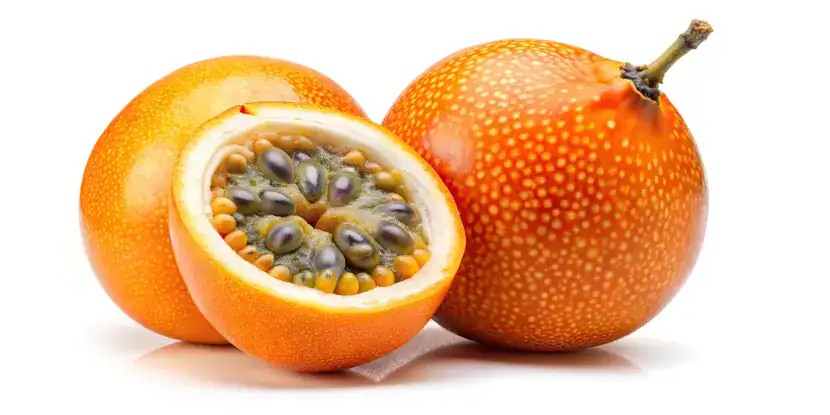
A sliced Giant Granadilla fruit with its seedy, tangy pulp.
Best Varieties for Southern California
Passion fruit (genus Passiflora) is native to Brazil, Argentina, and Paraguay. Of the 500-plus species, only a handful bear edible fruit. Others are grown purely for their ornamental flowers.
The best varieties for Southern California include:
- Purple Passion Fruit (Passiflora edulis): Produces small to medium-sized purple fruits with a tangy, aromatic pulp. It prefers cooler coastal climates.
- Yellow Passion Fruit (Passiflora edulis f. flavicarpa): Larger and sweeter than the purple variety, it does best in warmer inland areas.
- Frederick: This hybrid is a vigorous grower with cold tolerance and a high fruit yield.
- Giant Granadilla (Passiflora quadrangularis): Grows large fruits up to 8 inches long with a sweet and tangy flavor.
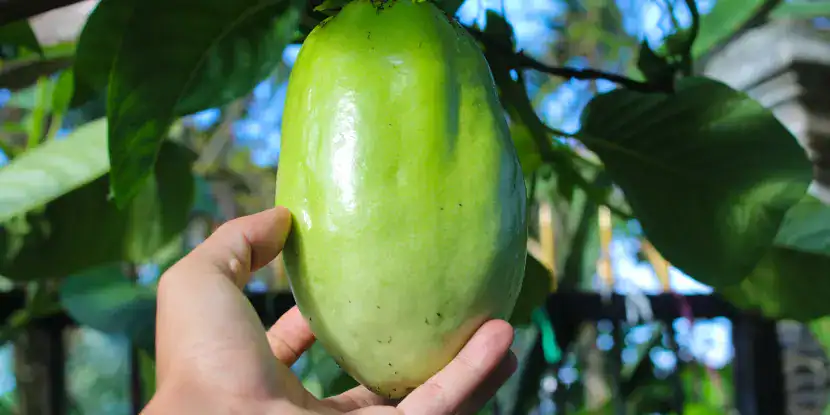
This Giant Granadilla fruit is almost football-sized (Nerf football, anyway)!
Propagating Passion Fruit
Passion fruit plants can be grown from seeds or cuttings:
From Seeds
- Scoop seeds from a ripe passion fruit, rinse off the pulp, and allow them to dry.
- Plant the seeds in nutrient-rich soil, keeping them moist.
- Germination typically takes 2–4 weeks.
From Cuttings (most reliable method)
- Select healthy, semi-hardwood cuttings 8–12 inches long.
- Remove the lower leaves and plant them in a well-draining propagation mix.
- Keep the cuttings in a warm, humid environment until roots form in 4–6 weeks.
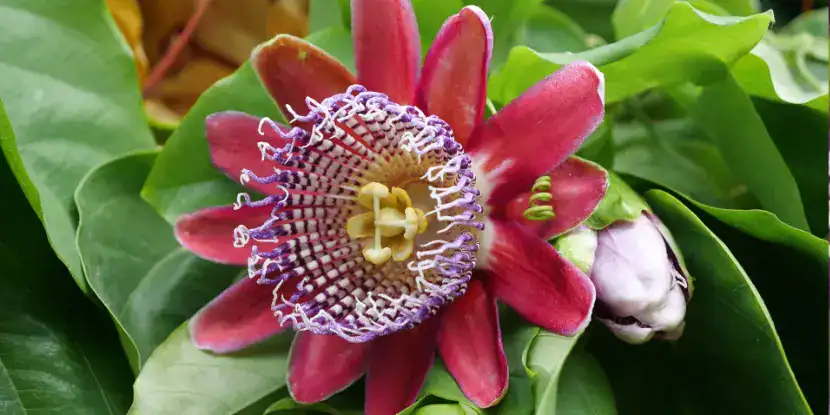
The exquisite flower of a Giant Granadilla (Passiflora quadrangularis).
Optimal Growing Conditions
Light
- Passion fruit plants require at least 6–8 hours of direct light daily.
- A sunny, south-facing location is ideal.
Temperature
- These tropical plants prefer warm climates.
- They flourish in temperatures ranging from 60–85°F, but can tolerate brief dips to 30°F.
- Mulching helps protect roots during occasional frosts.
Soil
- Ensure well-draining soil, rich in organic matter, with a pH between 6.0 and 6.5.
- Adding compost or aged manure improves fertility and drainage.
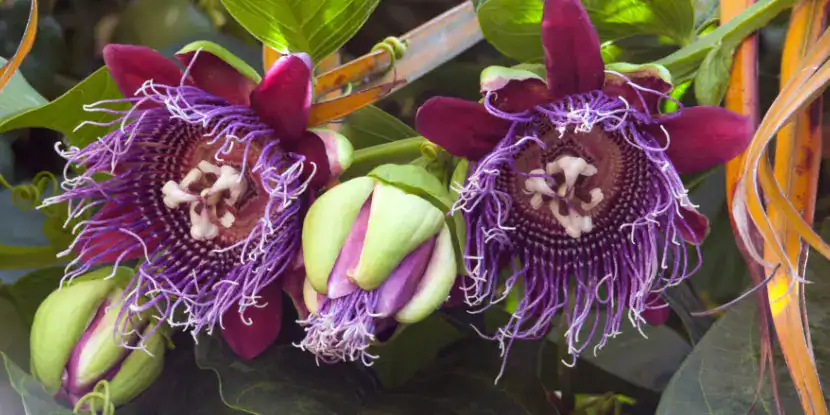
Passion fruit vines are grown for their blooms as much as for their fruit.
Planting Passion Fruit
In Southern California, the best time to plant passion fruit is typically February through April. The danger of frost has passed, and the soil is warming up, promoting strong root development.
In the Garden
- Choose a location near a sturdy structure like a trellis or fence. Passion fruit is a climbing vine.
- Dig a hole twice as wide and deep as the root ball.
- Mix compost into the soil at the bottom of the hole.
- Place the plant, backfill with soil, and water thoroughly.
In a Pot
- Use a large pot (at least 20 gallons) with drainage holes.
- Fill with high-quality potting mix blended with compost.
- Plant the vine and position the pot where it can receive direct sunlight.
- Add a climbing support, such as a stake or small trellis.
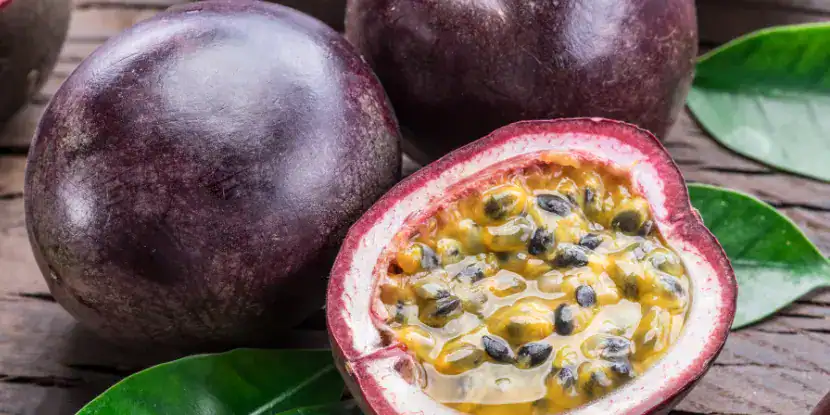
Passion fruits and a cross-section of pulpy juice filled with seeds.
Passion Fruit Plant Care
Passion fruit plants typically have a productive lifespan of 3 to 7 years, depending on the variety, growing conditions, and care provided.
Under optimal conditions, they can bear fruit as early as 12 to 18 months after planting. Their peak production occurs during the first few years; older plants may see a decline in fruit yield and quality over time.
Regular pruning, adequate watering, soil enrichment, and pest control can extend productivity. For long-term cultivation, growers often replace older vines with new ones every few years to maintain consistent harvests.
Water
- Keep the soil consistently moist, especially during hot, dry weather.
- Avoid overwatering. Soggy soil can cause root rot.
Fertilizer
- Feed your plant with a balanced fertilizer (e.g., 10-10-10) every 4–6 weeks during the growing season.
- Organic options like compost tea or fish emulsion are also effective.
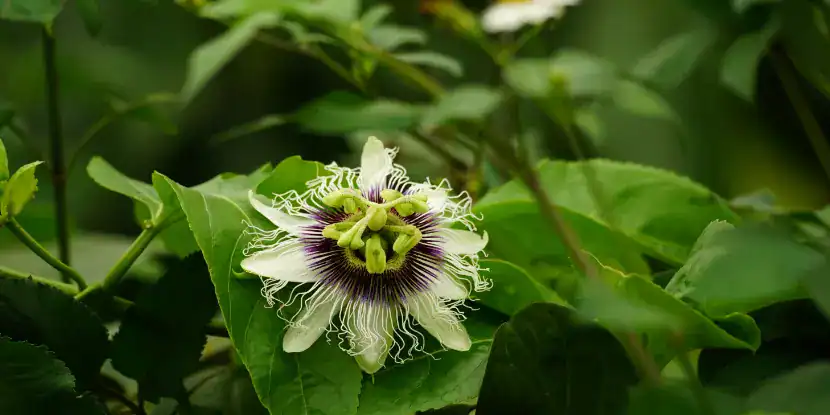
Close-up of a Passiflora edulis flower.
Pests & Diseases
- Common Pests: Aphids, mealybugs, and fruit flies. Use insecticidal soap or neem oil to control outbreaks.
- Diseases: Passion fruit is susceptible to fungal infections like Fusarium wilt and crown rot. Ensure proper drainage and air circulation to prevent these issues.
Pruning
- Trim the plant to manage the vine growth, increase airflow, and encourage fruiting.
- Remove dead or weak stems.
- For older plants, cut back after the harvest season to stimulate new growth.
Harvesting Passion Fruit
Passion fruit is ready for harvest when it falls from the vine. Ripe fruit is slightly wrinkled and has a deep, vibrant color (purple or yellow, depending on the variety).
Storage & Uses
- Store fresh fruit in the refrigerator for up to 2 weeks.
- Use the juicy pulp in smoothies, desserts, marinades, or salad dressings.
- Freeze excess pulp for future use.

Anyone for a refreshing passion fruit beverage?
FAQs: Growing Passion
Q: How long does it take for passion fruit to bear fruit?
It typically takes 12–18 months to produce fruit after planting passion fruit vines.
Q: Do I need more than one plant for pollination?
Most varieties are self-fertile, but planting multiple vines can increase yield.
Q: Why aren’t my passion fruit flowers turning into fruit?
Poor pollination is often the cause. Encourage pollinators like bees or hand-pollinate to improve fruit set.
Q: How long do passion fruit vines live?
Passion fruit vines are most productive in their first 4–5 years, but they can live up to 7 years with proper care.
Q: Can I grow passion fruit indoors?
While possible, passion fruit requires significant sunlight and space, making outdoor growth more practical.
Q: What should I do if my leaves turn yellow?
Yellowing leaves may indicate overwatering, nutrient deficiencies, or pests. Inspect the plant and adjust care accordingly.
Q: How do I protect my vine from frost?
Mulch heavily around the base and cover the vine with frost cloth when temperatures drop below 30°F.
Q: Are passion fruit vines invasive?
If not managed, passion fruit can become invasive. Regular pruning keeps the plant under control.

